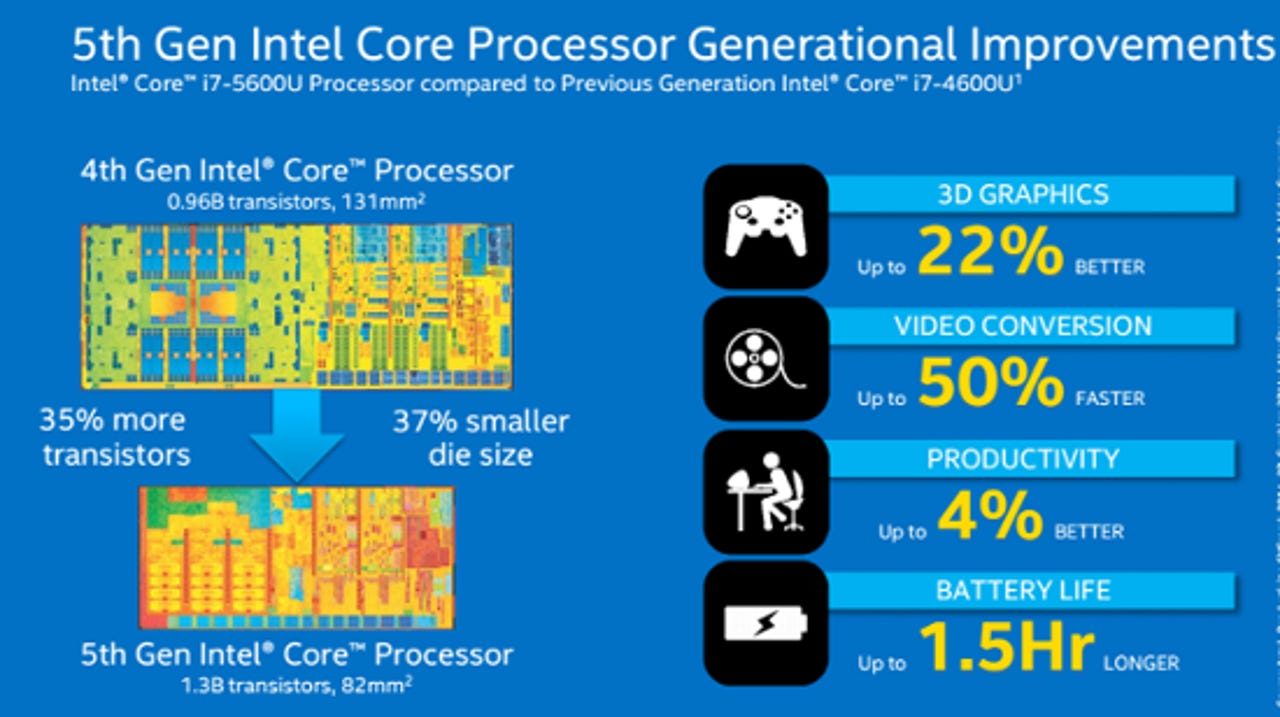Intel reveals Broadwell - the faster processor it hopes will spearhead PC revival

Intel has revealed more details on the faster, more efficient processors it hopes will spark a revival in PC sales.
The first laptops and PCs with Intel's new Broadwell processors will be available this month, with the chipmaker promising machines whose performance and battery life outstrips that of existing computers based on Intel's Haswell chips.
To create Broadwell Intel took the Haswell processor architecture and shrunk the circuitry using a 14nm manufacturing process, allowing Intel to pack more than one third more transistors onto a smaller chip.

At the high end Intel expects Broadwell processors will drive screens that are larger, bigger than 13 inches and with resolutions of up to 3200 x 1800 pixels, and machines with longer battery life, more than 11 hours. It hopes these features will persuade people and businesses to upgrade.
"We think these new features and capabilities can spark a PC refresh," said Karen Regis, mobile platform marketing manager at Intel.
More CES 2016
"More than 600 million PCs are four years or older, which represents a huge opportunity for Intel and its partners," she said - adding that office performance and battery life of a Broadwell-based Core i5 device is at least twice that of a 2010 Core i5 machine.
There are also signs that after years of declining PC sales that consumers and businesses may have begun upgrading to new machines.
The first laptops to be powered by Broadwell processors match Intel's expectation for larger screens. The Broadwell-driven Acer Chromebook 15 series features the first Chromebooks with a 15.6-inch display, with a resolution of 1920 x 1080 or 1366 x 768 depending on the model. It will ship with either a Core i3 or Celeron processor based on the Broadwell architecture, 16GB or 32GB SSD for storage and 2GB or 4GB of RAM. The machine will be priced from $249.99 .
Also sporting Broadwell processors are Acer's new R13 and S7 laptop family, both of which support the newest 802.11ac networking standard, which allows for wi-fi connections dozens of times faster than offered by 802.11n connections provided by most machines today.
The R13 is less than one inch thick, weighs just over three pounds and has a rotatable 13.3-inch display, with a resolution of up to 2560 x 1440, and Acer claiming up to 10 hours of battery life. The machines come with up to 1TB of SSD storage, 8GB of memory, and with a display protected by Corning Gorilla Glass 3 and a resolution of up to 2560 x 1440.
The update to Acer's all-aluminium S7 series will ship with a .51 inch thick case, weigh 2.87 pounds, and comes with a tiltable, touchscreen display covered by Corning Gorilla Glass 2. Available with 8GB of memory, 128GB or 256GB of SSD storage, up to 10 hours of battery life by Acer's estimation and a resolution of up to 2560 x 1440.
Both the S7 and R13 will be available later this month, with pricing yet to be revealed.
Broadwell processors will be aimed at a range of form factors, including: notebooks, touch-enabled computers, 2-in-1s, Ultrabooks, all-in-one PCs and mini-PCs like Intel's Next Unit of Computing machines. Systems based on consumer and corporate Broadwell varieties are expected to be available from 18 January. These first Broadwell processors are dual-core, with quad-core chips reportedly due to be released in the second half of the year.
There are 14 new Broadwell-based Core processors aimed at the consumer and business market. Ten of the processors will feature Intel HD 5500 and 6000 integrated graphics and have a maximum power consumption of 15W, while four will feature the more powerful Intel Iris 6100 integrated graphics and draw up to 28W. Initial systems will feature Intel HD graphics, with Intel Iris graphics systems to follow later. Broadwell will be used in Core i3, i5 and i7 processors for more powerful systems and Core M for mobile systems where battery life is a priority.
AR + VR
All integrated graphics are going to support DirectX 11.2, the development version of DirectX 12, OpenGL 4.3 standards for gaming, 4K (3840x2160) video playback and displays up to 4K in resolution.
Each Broadwell processor will feature electronics dedicated to helping 3D cameras carry out gesture and facial expression using Intel RealSense technology.
Intel's RealSense technology uses three cameras to measure image depth and the shape of objects in photos. The tech allows the focal point to be shifted after an image is taken and other neat photo-editing tricks, as well as 3D scans of people and objects to be created.
Broadwell processors will also support WiDi v5.1, Intel's wireless display technology that allows audio and video up to 4K in resolution to be streamed to a display without cables. Intel Pro WiDi adds various security and privacy controls. Support for wireless gigabit data connections should also allow peripherals such as keyboards and mice to be connected without leads.
At the heart of each Broadwell processor is Intel's fifth generation processor core, with 1.9 billion transistors packed onto an 133 mm2 die. Each Broadwell processor revealed today includes two CPU cores, integrated graphics processor and L3 cache that is shared between the CPU and GPU. Also on board is circuitry dedicated to the memory controller I/O and system agent, display engine.
Here are the technical specs and prices for the dual-core processors in the Broadwell family.